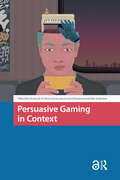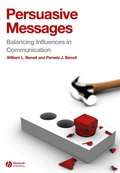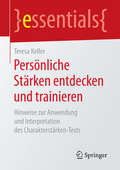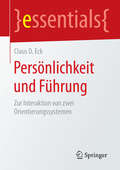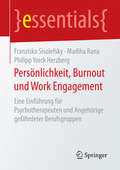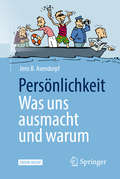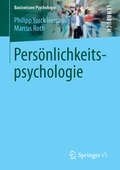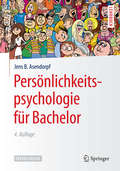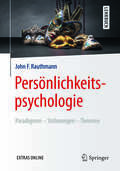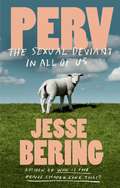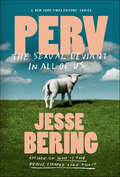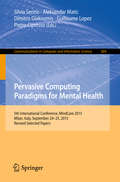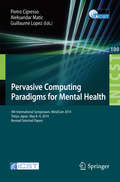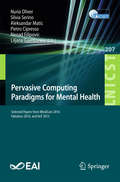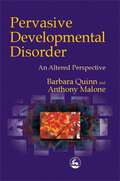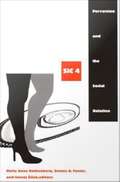- Table View
- List View
Persuasive Gaming in Context (Games and Play)
by Ben Schouten Joost Raessens Teresa de la Hera Jeroen JanszThe rapid developments in new communication technologies have facilitated the popularization of digital games, which has translated into an exponential growth of the game industry in recent decades. The ubiquitous presence of digital games has resulted in an expansion of the applications of these games from mere entertainment purposes to a great variety of serious purposes. In this edited volume, we narrow the scope of attention by focusing on what game theorist Ian Bogost has called 'persuasive games', that is, gaming practices that combine the dissemination of information with attempts to engage players in particular attitudes and behaviors. This volume offers a multifaceted reflection on persuasive gaming, that is, on the process of these particular games being played by players. The purpose is to better understand when and how digital games can be used for persuasion by further exploring persuasive games and some other kinds of persuasive playful interaction as well. The book critically integrates what has been accomplished in separate research traditions to offer a multidisciplinary approach to understanding persuasive gaming that is closely linked to developments in the industry by including the exploration of relevant case studies.
Persuasive Messages: The Process of Influence
by William L. Benoit Pamela J. BenoitWilliam and Pamela Benoit's (both communication, U. of Missouri- Columbia) textbook offers college students practical advice on refining one's purpose, understanding one's audience, and designing a persuasive message. Coverage includes key concepts, sources, and the relationship between attitudes and behavior; the mechanics of creating persuasive messages; theories of persuasion; and the use of persuasion in two particular contexts, advertising and political campaigns.
Persuasive Technology
by Alexander Meschtscherjakov Boris De Ruyter Verena Fuchsberger Martin Murer Manfred TscheligiThis book constitutes therefereed proceedings of the 11th International Conference on PersuasiveTechnology, PERSUASIVE 2016, held in Salzburg, Austria, in April 2016. The 27 revised full papers and 3 revised short papers presented were carefullyreviewed and selected from 73 submissions. The papers are grouped in topicalsections on individual differences, theoretical reflections, prevention andmotivation, methods and models, games and gamification, interventions forbehavior change, and design strategies and techniques.
Persönliche Stärken entdecken und trainieren: Hinweise zur Anwendung und Interpretation des Charakterstärken-Tests (essentials)
by Teresa KellerIn diesem essential stellt Teresa Keller aktuelle Erkenntnisse vor, wie die eigenen Stärken systematisch entdeckt und erforscht werden können. Damit diese auch im Alltag Anwendung finden, präsentiert die Autorin eine Vielzahl konkreter Anregungen und Impulse, wie Stärken bewusst trainiert und weiterentwickelt werden können. Der VIA-Charakterstärkentest, der eine schnelle und wissenschaftlich fundierte Möglichkeit der Stärkenerkennung ermöglicht, steht dabei im Mittelpunkt. Ergänzend werden weitere Methoden zur Entdeckung von Stärken vorgestellt. Eine ausführliche Erläuterung von 24 zentralen Stärken bietet Raum für Selbstreflexion und liefert überraschende Erkenntnisse. Denn das alltägliche Anwenden unserer fünf wichtigsten Stärken führt zu mehr Selbstbewusstsein, macht uns leistungsfähiger und erfolgreicher.
Persönlichkeit und Führung: Zur Interaktion von zwei Orientierungssystemen (essentials)
by Claus D. EckClaus D. Eck beschreibt das Zusammenspiel von zwei hochkomplexen Phänomenen: Führung und Persönlichkeit. Diese beiden Faktoren sind nicht voneinander trennbar und ständig aufeinander bezogen. Denn Führung wird nicht von Strukturen oder Systemen ausgeübt, sondern von Personen, und sie bezieht sich auf Personen. Die Persönlichkeit und die Führung sind im Sinne von Waldenfels "Hyperphänomene". Führen ist mehr als das Schließen der unvermeidlichen Lücken und somit auch mehr als eine Ergänzung der Managementfunktion. Was Führung ausmacht, sind der Wille und die Fähigkeit, auf andere einen maßgebenden Einfluss auszuüben, andere zu befähigen, selbsttätig die gegebenen Herausforderungen zu meistern. Führung ist punktuell, aber entscheidend, sie weiß sich immer auch zurückzunehmen und fördert so die relative Autonomie der Geführten.
Persönlichkeit und Selbststeuerung der Generation Z: Ein Leitfaden für Bildungsträger und die mittelständische Unternehmenspraxis (essentials)
by Karin MeyerDie Generation Z stellt konventionelle Konzepte in Frage. Von Bedeutung für den Erfolg von Unternehmen und Bildungsträgern ist es daher, sie als zukünftige Mitarbeiter und Lernende zu verstehen sowie deren Stärken und Schwächen zu kennen. Dieses essential gibt wesentliche Einblicke in die Persönlichkeit und Selbststeuerung der jungen Generation. Es werden Handlungsempfehlungen im Checklisten-Format abgebildet – mit dem Ziel, Bewährtes zum Wohl aller Beteiligten zu verändern.
Persönlichkeit, Burnout und Work Engagement: Eine Einführung für Psychotherapeuten und Angehörige gefährdeter Berufsgruppen (essentials)
by Philipp Yorck Herzberg Franziska Sisolefsky Madiha RanaBei diesem essential handelt es sich um eine praxisnahe Einführung in die Thematiken Burnout und Work Engagement, die als Gegenpole vor allem von der eigenen Persönlichkeit abhängig sind und in der psychotherapeutischen Praxis eine große Bedeutung aufweisen. Das Autorenteam stellt die wichtigsten Definitionen und klare Symptomchecklisten vor und erläutert den Einfluss der Persönlichkeit auf die Entstehung von Burnout sowie von positivem Work Engagement. In einem Praxiskapitel werden die Auswirkungen der „Big Five“-Persönlichkeitseigenschaften auf Work Engagement und Burnout am Beispiel von Assistenzärzten veranschaulicht.
Persönlichkeit: was uns ausmacht und warum
by Jens B. AsendorpfPersönlichkeit: was uns ausmacht und warum Wie unterscheiden wir uns in der Persönlichkeit, wie entstehen solche Unterschiede, welche Rolle spielen hierbei Gene und Umwelt? Dieses Sachbuch gibt eine fundierte, aktuelle Übersicht über den Stand der psychologischen Forschung zu diesen Fragen. Jens Asendorpf, einer der renommiertesten Persönlichkeitspsychologen unserer Zeit, steckt darin einen weiten Themenbogen ab. Wie äußert sich die Persönlichkeit im Verhalten und in den sozialen Beziehungen, kann man Persönlichkeitsbeurteilungen trauen, was sind die „Big Five“? Lässt sich die Persönlichkeit aus Spuren im Internet erschließen, wie kann man emotionale und soziale Kompetenzen testen? Wie stark ändert sich die Persönlichkeit im Verlauf des Lebens, was sagen Persönlichkeitsunterschiede zwischen Kindern über die späteren Unterschiede im Erwachsenenalter aus? In welchem Maße ist unsere Persönlichkeit durch unsere Gene und unsere nahen Beziehungen bestimmt, und wie stark prägt umgekehrt unsere Persönlichkeit unsere Beziehungen? Können und sollten wir unsere Persönlichkeit ändern? Der Autor schildert nicht nur Ergebnisse der Forschung, sondern auf allgemeinverständliche Art auch die Methoden, auf denen diese Erkenntnisse beruhen. Damit hebt sich dieses Buch von den meisten psychologischen Ratgebern auf dem Markt ab. Es ist anspruchsvoll, erfordert aber keine Fachkenntnisse. Die Verständlichkeit wird durch viele Grafiken, einfache Tabellen und Kästen mit einer prägnanten Beschreibung von Studien und Methoden unterstützt. Für alle, die sich ein Bild von der heutigen psychologischen Forschung und ihren Ergebnissen zum Thema Persönlichkeit machen wollen, ist dieses Buch unentbehrlich.
Persönlichkeitsbildung durch Tanz: Theoretische Herleitung und empirische Analyse des tänzerischen Selbstkonzepts bei Kindern
by Helena RudiAuf persönlichkeitsbildender Ebene werden tänzerischen Aktivitäten eine Vielzahl an positiven Effekten zugeschrieben, insbesondere, wenn sie partizipative oder experimentelle Prinzipien und ästhetisch-kulturelle Bildungsinhalte fokussieren. Mit der Nutzung domainunspezifischer Theorien und Erhebungsverfahren können bisherige Forschungsergebnisse allerdings nur bedingt diskutiert und miteinander verglichen werden. Die Entwicklung tanzspezifischer Modelle und Erhebungsverfahren erweist sich damit als notwedig.Vor diesem Hintergrund zielt die vorliegende Schrift auf die theoretische Herleitung und empirische Überprüfung eines tänzerischen Selbstkonzepts bei Kindern im Alter von acht bis zwölf Jahren ab. Die Autorin entwickelt und überprüft dieses nicht nur mithilfe qualitativer und quantitativer Verfahren im Mixed Methods Design, sie bettet ihr Konzept unter pädagogischer Perspektivierung auch in aktuelle Forschungsdiskurse der ästhetischen und kulturellen Bildung (bspw. Digitalität) sowie der Selbstkonzeptforschung (bspw. soziale Interaktionsprozesse) ein.
Persönlichkeitspsychologie (Basiswissen Psychologie)
by Marcus Roth Philipp Yorck HerzbergWas ist Persönlichkeit? Was macht die Einzigartigkeit jedes Menschen aus? Können wir uns ändern? Dieses Lehrbuch liefert einen kompakten und verständlichen Überblick über das Fach "Persönlichkeitspsychologie und Differentielle Psychologie". Die Fokussierung auf notwendiges Basiswissen steht dabei im Vordergrund und bietet eine erste Orientierung.
Persönlichkeitspsychologie für Bachelor
by Jens B. AsendorpfDieses Lehrbuch erklärt alle wichtigen Themen des psychologischen Grundlagenfachs „Persönlichkeitspsychologie“ kompakt und verständlich. Zahlreiche Fallbeispiele und Praxishinweise stellen dabei den Bezug zum Alltag her, Lernziele, Kontrollfragen und weiterführende Literatur helfen bei der gezielten Prüfungsvorbereitung. Doch das Buch bietet noch viel mehr: Die begleitende Website lehrbuch-psychologie.springer.com enthält kostenlose Lerntools für Studierende sowie Lehrmaterialien für Dozierende zum Download.
Persönlichkeitspsychologie für Bachelor (Springer-Lehrbuch)
by Jens B. AsendorpfDieses Lehrbuch erklärt alle wichtigen Themen des psychologischen Grundlagenfachs „Persönlichkeitspsychologie“ kompakt und verständlich. Zahlreiche Fallbeispiele und Praxishinweise stellen dabei den Bezug zum Alltag her, Lernziele, Kontrollfragen und weiterführende Literatur helfen bei der gezielten Prüfungsvorbereitung. Doch das Buch bietet noch viel mehr: Die begleitende Website www.lehrbuch-psychologie.springer.com enthält kostenlose Lerntools für Studierende, mp3-Hörbeiträge zum Download sowie Lehrmaterialien für Dozierende.
Persönlichkeitspsychologie: Paradigmen – Strömungen – Theorien (Springer-Lehrbuch)
by John F. RauthmannDieses Lehrbuch bietet einen umfassenden, aber dennoch kompakten Überblick über die Vielfalt der Ansätze in der Persönlichkeitspsychologie. Welche Paradigmen, Strömungen und Theorien gibt es in der Persönlichkeitsforschung? Womit beschäftigen sie sich, was zeichnet sie jeweils aus? Wie kann man sie miteinander vergleichen? Sie erhalten durch die Auseinandersetzung mit diesen Fragen eine profunde Einführung in die Persönlichkeitspsychologie. Damit werden Sie sich in dem Fach besser zurechtfinden. Umfassend und kompakt ▬ Alle wichtigen Ansätze der Persönlichkeitspsychologie umfassend in einem Buch zusammengestellt ▬ Veraltete Ansätze: vorwissenschaftlich, psychodynamisch, lerntheoretisch ▬ Klassische Ansätze: humanistisch, kognitiv, dispositional ▬ Moderne Ansätze: biologisch, transaktional Besser lernen ▬ Vorstellung, Erklärung, Rezeption und Kontrastierung der Ansätze anhand einheitlicher Kriterien ▬ Mit vielen didaktischen Elementen, Tabellen und Abbildungen, die wichtige Informationen klar herausstellen und auf einen Blick zusammenfassen, sowie Online Zusatzmaterialien Für Fortgeschrittene ▬ Fortgeschrittene Psychologie-Studierende im Bachelor ▬ Psychologie-Studierende im Master ▬ Studierende anderer Fachrichtungen (z. B. Pädagogik), die Fachkenntnisse in der Psychologie mitbringen und sich für eine wissenschaftliche Auseinandersetzung mit Persönlichkeit und individuellen Unterschieden interessieren
Perv: The Sexual Deviant in All of Us
by Jesse Bering"As a sex writer, Jesse Bering is fearless—and peerless." —Dan Savage <P><P>"You are a sexual deviant. A pervert, through and through." We may not want to admit it, but as the award-winning columnist and psychologist Jesse Bering reveals in Perv, there is a spectrum of perversion along which we all sit. Whether it's voyeurism, exhibitionism, or your run-of-the-mill foot fetish, we all possess a suite of sexual tastes as unique as our fingerprints—and as secret as the rest of the skeletons we've hidden in our closets. <P><P>Combining cutting-edge studies and critiques of landmark research and conclusions drawn by Sigmund Freud, Alfred Kinsey, and the DSM-5, Bering pulls the curtain back on paraphilias, arguing that sexual deviance is commonplace. He explores the countless fetishists of the world, including people who wear a respectable suit during the day and handcuff a willing sexual partner at night. But he also takes us into the lives of "erotic outliers," such as a woman who falls madly in love with the Eiffel Tower; a pair of deeply affectionate identical twins; those with a particular penchant for statues; and others who are enamored of crevices not found on the human body. <P><P>Moving from science to politics, psychology, history, and his own reflections on growing up gay in America, Bering confronts hypocrisy, prejudice, and harm as they relate to sexuality on a global scale. Humanizing so-called deviants while at the same time asking serious questions about the differences between thought and action, he presents us with a challenge: to understand that our best hope of solving some of the most troubling problems of our age hinges entirely on the amoral study of sex. <P><P>As kinky as it is compassionate, illuminating, and engrossing, Perv is an irresistible and deeply personal book. "I can't promise you an orgasm at the end of our adventure," Bering writes, "but I can promise you a better understanding of why you get the ones you do."
Perv: The Sexual Deviant in All of Us
by Jesse Bering"As a sex writer, Jesse Bering is fearless—and peerless." —Dan Savage"You are a sexual deviant. A pervert, through and through." We may not want to admit it, but as the award-winning columnist and psychologist Jesse Bering reveals in Perv, there is a spectrum of perversion along which we all sit. Whether it's voyeurism, exhibitionism, or your run-of-the-mill foot fetish, we all possess a suite of sexual tastes as unique as our fingerprints—and as secret as the rest of the skeletons we've hidden in our closets.Combining cutting-edge studies and critiques of landmark research and conclusions drawn by Sigmund Freud, Alfred Kinsey, and the DSM-5, Bering pulls the curtain back on paraphilias, arguing that sexual deviance is commonplace. He explores the countless fetishists of the world, including people who wear a respectable suit during the day and handcuff a willing sexual partner at night. But he also takes us into the lives of "erotic outliers," such as a woman who falls madly in love with the Eiffel Tower; a pair of deeply affectionate identical twins; those with a particular penchant for statues; and others who are enamored of crevices not found on the human body. Moving from science to politics, psychology, history, and his own reflections on growing up gay in America, Bering confronts hypocrisy, prejudice, and harm as they relate to sexuality on a global scale. Humanizing so-called deviants while at the same time asking serious questions about the differences between thought and action, he presents us with a challenge: to understand that our best hope of solving some of the most troubling problems of our age hinges entirely on the amoral study of sex.As kinky as it is compassionate, illuminating, and engrossing, Perv is an irresistible and deeply personal book. "I can't promise you an orgasm at the end of our adventure," Bering writes, "but I can promise you a better understanding of why you get the ones you do."
Pervasive Computing Paradigms for Mental Health
by Silvia Serino Aleksandar Matic Dimitris Giakoumis Guillaume Lopez Pietro CipressoThis book constitutes the refereed proceedings of the 5th International Conference on Pervasive Computing Paradigms for Mental Health, MindCare 2015, held in Milan, Italy, in September 2015. The 23 full papers and 6 short papers presented were carefully reviewed and selected from 40 submissions. The papers deal with the use of technologies in favor of maintaining and improving mental wellbeing. They focus on building new computing paradigms and on addressing a multitude of challenges in mental healthcare, for example in psychiatric and psychological domains with emphasis on new technologies, such as video and audio technologies and mobile and wearable computing.
Pervasive Computing Paradigms for Mental Health
by Aleksandar Matic Guillaume Lopez Pietro CipressoThis book constitutes revised post-proceedings of the 4th International Symposium on Pervasive Computing Paradigms for Mental Health, MindCare 2014, held in Tokyo, Japan, in May 2014. The 11 full and 5 short papers presented were carefully reviewed and selected from 26 submissions for inclusion in the proceedings. The papers are organized in topical sections on recognition and assessment, mental health management, improving communication, depression, and self-applied treatments.
Pervasive Computing Paradigms for Mental Health: 4th International Symposium, Mindcare 2014, Tokyo, Japan, May 8-9, 2014, Revised Selected Papers (Lecture Notes of the Institute for Computer Sciences, Social Informatics and Telecommunications Engineering #100)
by Liljana Gavrilovska Silvia Serino Aleksandar Matic Pietro Cipresso Nenad Filipovic Nuria OliverThis book constitutes the refereed proceedings of the 6th International Symposium on Pervasive Computing Paradigms for Mental Health, MindCare 2016, held in Barcelona, Spain, in November 2016, and the Second International Conference of Future Access Enablers of Ubiquitous and Intelligent Infrastructures, Fabulous 2016, Belgrade, Serbia, October 24-26, 2016, and the Third International Conference on Interoperability in IoT, IIoT 2015, Rome, Italy, October 26-27, 2015. The 24 papers were selected from 32 submissions. MindCare presents technologies in favor of maintaining and improving psychological well-being. Fabulous presents broad areas of future wireless networks, ambient and assisted living and smart infrastructures in order to interact, exchange ideas, expertise, experience and know-how. And finally IIoT presents tools and services in home automation and industrial service.
Pervasive Developmental Disorder: An Altered Perspective
by Anthony Malone Barbara H. QuinnPervasive Developmental Disorder, or PDD, is the umbrella term used to cover the whole family of autistic spectrum disorders - including autism and Asperger Syndrome. Within this group there is a subgroup called NOS - not otherwise specified - which covers the conditions which do not quite meet the diagnostic criteria for autism or Asperger Syndrome. Because PDD covers such a wide spectrum, it presents very differently from child to child. Written principally for parents, this is a book which explains what it means for your child to be diagnosed with PDD, NOS, autism or Asperger Syndrome, and where you go from there. The authors describe the symptoms of PDD, what a diagnosis means, how a child fits into the diagnostic terminology and the diagnostic procedures involved. They also review associated disorders such as OCD, and discuss the different treatments and therapies available. The book includes frequently-asked questions, as well as the experiences of other parents. It is accessible, informative and supportive, a practical introduction to PDD.
Perverse Memory and the Holocaust: A Psychoanalytic Understanding of Polish Bystanders (Memory Studies: Global Constellations)
by Jan BorowiczPerverse Memory and the Holocaust presents a new theoretical approach to the study of Polish memory bystanders of the Holocaust. Drawing on psychoanalytic theory, it examines representations of the Holocaust in order to explore the perverse mechanisms of memory at work, in which surface a series of phenomena difficult to remember: the pleasure derived from witnessing scenes of violence, identification with the German perpetrators of violence, the powerful fear of revenge at the hands of Jewish victims, and the adoption of the position of genocide victims. Moving away from the focus of previous psychoanalytic studies of memory on questions of mourning, melancholy, repressed memory, and loss, this volume considers the transformation of the collective identity of those who remained in the space of past Holocaust events: bystanders, who partook in the events and benefited from the extermination of the Jews. A critique of ‘perverse memory’ that hampers attempts to work through what is remembered, this book will be of interest to scholars across the social sciences working in the fields of Holocaust studies, memory studies, psychoanalytic studies, and cultural studies.
Perverse Psychology: The pathologization of sexual violence and transgenderism (Concepts for Critical Psychology)
by Jemma ToshPsychology defines people who take pleasure in the suffering of others as having a form of mental illness, while media representations frame such behaviour as ‘evil’. This is hotly contested territory, not least where sexual violence is concerned – violence which feminist voices argue is related to power rather than sex. Perverse Psychology examines psychiatric constructions of sexual violence and transgender people from the 19th century until the latest DSM-5 diagnoses. It uses discourse analysis to interrogate the discursive boundaries between 'normal' and 'abnormal' rape, as well as the pathologization of gender and sexual diversity. The book illuminates for the first time the parallels between psychiatry’s construction of gender diversity and sexual violence, and leads us to question whether it is violence that the profession finds so intriguing, or the gender nonconformity it represents. Perverse Psychology is ideal reading for postgraduate students and researchers in the fields of critical psychology, discourse analysis, feminism, transgender people, LGBT psychology, and the history of psychiatry.
Perversion Now!
by Diana Caine Colin WrightThis book enabling practicing analysts from around the world to interrogate the contemporary relevance of Lacanian theory for a category at once formative and deeply problematic for psychoanalysis: perversion.
Perversion and Modern Japan: Psychoanalysis, Literature, Culture (Routledge Contemporary Japan Series)
by Nina CornyetzHow did nerves and neuroses take the place of ghosts and spirits in Meiji Japan? How does Natsume Soseki’s canonical novel Kokoro pervert the Freudian teleology of sexual development? What do we make of Jacques Lacan’s infamous claim that because of the nature of their language the Japanese people were unanalyzable? And how are we to understand the re-awakening of collective memory occasioned by the sudden appearance of a Japanese Imperial soldier stumbling out of the jungle in Guam in 1972? In addressing these and other questions, the essays collected here theorize the relation of unconscious fantasy and perversion to discourses of nation, identity, and history in Japan. Against a tradition that claims that Freud’s method, as a Western discourse, makes a bad ‘fit’with Japan, this volume argues that psychoanalytic reading offers valuable insights into the ways in which ‘Japan’ itself continues to function as a psychic object. By reading a variety of cultural productions as symptomatic elaborations of unconscious and symbolic processes rather than as indexes to cultural truths, the authors combat the truisms of modernization theory and the seductive pull of culturalism. This volume also offers a much needed psychoanalytic alternative to the area studies convention that reads narratives of all sorts as "windows" offering insights into a fetishized Japanese culture. As such, it will be of huge interest to students and scholars of Japanese literature, history, culture, and psychoanalysis more generally.
Perversion and the Social Relation: Sic 4
by Slavoj I Ek Molly Anne Rothenberg Dennis A. FosterThe masochist, the voyeur, the sadist, the sodomite, the fetishist, the pedophile, and the necrophiliac all expose hidden but essential elements of the social relation. Arguing that the concept of perversion, usually stigmatized, ought rather to be understood as a necessary stage in the development of all non-psychotic subjects, the essays in Perversion and the Social Relation consider the usefulness of the category of the perverse for exploring how social relations are formed, maintained, and transformed. By focusing on perversion as a psychic structure rather than as aberrant behavior, the contributors provide an alternative to models of social interpretation based on classical Oedipal models of maturation and desire. At the same time, they critique claims that the perverse is necessarily subversive or liberating. In their lucid introduction, the editors explain that while fixation at the stage of the perverse can result in considerable suffering for the individual and others, perversion motivates social relations by providing pleasure and fulfilling the psychological need to put something in the place of the Father. The contributors draw on a variety of psychoanalytic perspectives--Freudian and Lacanian--as well as anthropology, history, literature, and film. From Slavoj Zizek's meditation on "the politics of masochism" in David Fincher's movie Fight Club through readings of works including William Styron's The Confessions of Nat Turner, Don DeLillo's White Noise, and William Burroughs's Cities of the Red Night, the essays collected here illuminate perversion's necessary role in social relations. Contributors. Michael P. Bibler, Dennis A. Foster, Bruce Fink, Octave Mannoni, E. L. McCallum, James Penney, Molly Anne Rothenberg, Nina Schwartz, Slavoj Zizek
Perversion: A Jungian Approach
by Fiona RossTheoretical understanding of perversion is neglected in analytical psychology, and narrowly developed in psychoanalysis, where it traditionally refers to sexual perversion. Etymological exploration of the word "perversion", including its use in religious, moral, sociological and legal contexts, reveals a wider meaning than that adopted in psychoanalysis. The aim of the author is to revise the psychoanalytic model through the introduction of Jungian concepts that extend the understanding of perversion beyond the bounds of sexuality to a more general relational context. By describing the development of psychoanalytic thinking on perversion in detail, the author is able to highlight the central differences between the Freudian and Jungian interpretive traditions and to explain why Jungian ideas on perversion have remained underdeveloped, leading to the absence of a unique or available Jungian contribution to the theory of perversion.
